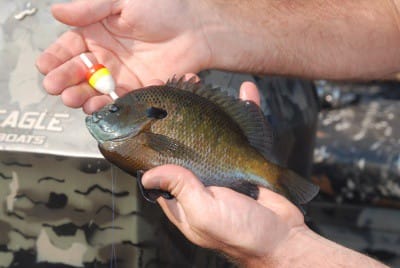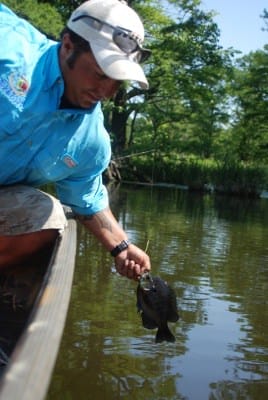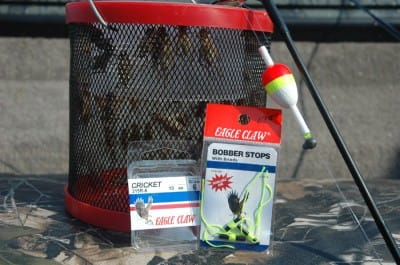 In my way of thinking, there’s not a single thing wrong with bluegills. Okay, so the man with the farm pond full of stunted ‘gills isn’t much pleased, but chances are that situation was – and is – his own fault. Still, and it’s my contention, the bluegill has few, if any, flaws. He’s eager to eat just about anything. If he weighed 15 pounds or more, you’d need deep-sea tackle to bring him boatside. He’s found from coast to coast, and in numbers rivaling much less desirable critters like mosquitoes, houseflies, and wood ticks. Bluegill fillets are fantastic table fare, and catching a bucket of ‘gills doesn’t require a $40,000 glass boat and $5,000 worth of fancy-schmancy fishing gear. No, sir; the boy with a cane pole, 8 feet of braided nylon line, a rusty No. 6 hook, and soup can full of redworms has everything the expert bluegill angler needs. So he – Mister Bluegill – has all that going for him.
In my way of thinking, there’s not a single thing wrong with bluegills. Okay, so the man with the farm pond full of stunted ‘gills isn’t much pleased, but chances are that situation was – and is – his own fault. Still, and it’s my contention, the bluegill has few, if any, flaws. He’s eager to eat just about anything. If he weighed 15 pounds or more, you’d need deep-sea tackle to bring him boatside. He’s found from coast to coast, and in numbers rivaling much less desirable critters like mosquitoes, houseflies, and wood ticks. Bluegill fillets are fantastic table fare, and catching a bucket of ‘gills doesn’t require a $40,000 glass boat and $5,000 worth of fancy-schmancy fishing gear. No, sir; the boy with a cane pole, 8 feet of braided nylon line, a rusty No. 6 hook, and soup can full of redworms has everything the expert bluegill angler needs. So he – Mister Bluegill – has all that going for him.
Perhaps best of all is the bluegill’s availability in one form or another throughout the whole of the calendar year. This willingness to cooperate is no more evident than during the summer months, also known as the warm water months when few species, save ‘cats, can be consistently found on the prowl. Unlike some game fish, warm water ‘gills are not cloaked in mystery, as some might think. Their teeth don’t fall out for two weeks as is the case with northern pike – NOTE: Yes, I know it’s an old wive’s tale, but it fits here – nor do they burrow themselves into the mud like hibernating toads, refusing even the finest wiggling worm or lively grasshopper. What is true is he’s out there, swimming the waters of each of Lower 48 States, and he’s more than happy to make himself the guest of honor at your next backyard fish fry.
The Bluegiller’s Mecca
Over the past 30 years, I’ve had the opportunity to fish from Florida to Washington state, and many of the waters in-between. Being I was raised by a crappie fisherman, much of this time was spent in search of panfish – ‘gills ranking very high on that list, if not riding atop it. And while I’m sure some will disagree, and a handful of those justifiably so, it’s my opinion, one formed after years of careful research otherwise known as fishing, it would be awfully tough to find a better bluegill pond than would be found on a little dollop of Tennessee water known as Reelfoot Lake.

Covering over 18,000 acres, Reelfoot is to big – and I do mean big – bluegills what hot dogs are to baseball games. Shallow, dark, and studded with thousands of cypress trees, living and deceased, the lake provides the perfect environment for ‘gill propagation and growth. Each summer, hundreds of panfish enthusiasts from around the country make the pilgrimage to Reelfoot; few, if any, drive away disappointed
And while it’s true the lake is full of big ‘gills, it doesn’t mean that big bluegills are everywhere to be found. This is particularly true during May and June, when the dark waters warm and progress of the bluegill spawn can be anywhere along a timeline from start to finish. The tricks to finding these fish, as my wife and I learned from Blue Bank Resort guide, Billy Blakley, which whom we fished early one summer, are several – and, as he explained, ones which can be applied to waters throughout the United States, both big and small. First, there are historic spawning beds. “Over the years,” said Blakley, “and especially during lower water, I’ve found hundreds of spawning bluegills. These fish will often come back year after year to these same spots. I can make a circuit,” he continued, “and just keep trying until I hit a bed that’s right.” Another tip the veteran guide pointed out was the importance of fishing where the fish are, and not where you want them to be. “A lot of people make the mistake of fishing too close to the shore,” said Blakley, subtly pointing at a neighboring boat with the tip of his ultralight rig. “A lot of these beds, they’re out away from the bank; some, 40 or 50 feet.” As demonstrated frequently during our three days on the water with him, Blakley showed a knack for visually pinpointing bedding ‘gills by spotting tell-tale – NOTE: Tell-tale to him, perhaps, but we weren’t the wiser by any means! – circular motifs of bubbles marking the surface. Some folks, he claimed, could even smell bedding bluegills. Myself, I was perfectly content letting Blakley choose the fishing locations, as long as I got to smell the kitchen cook’s biscuits and gravy every morning.
A day or two on the water with Blakley running out of Blue Bank Resort (bluebankresort.com; 877-258-3226) is not ridiculously inexpensive, but can put you light-years ahead on the learning curve when next you try your hand on the local farm pond bluegills. In fact, Julie and I were able to employ many of Blakley’s tactics here in eastern Iowa, with markedly improvements in our summer success with relatively pressured ‘gills on area quarries and public ponds. It was time well spent, and time very much recommended.

Summer Gear and Grub
If it’s possible to one-up the bluegill’s eagerness throughout the summer months, it would without question be the informality of the tackle required to catch him. While at Reelfoot, our basic tackle consisted of two-piece 60-inch ultralight Shakespeare spinning rods mated to the company’s tiny Synergy 200 reel spooled with #2 Trilene monofilament. Rounding out the rigging was a small slip bobber, bead, and just enough weight in the form of a reusable split shot so as settle the bobber about halfway under. A lively cricket was pinned through the collar on a No. 6 Eagle Claw Cricket Hook, and we were underway. Once home in Iowa, we used the same rig, replacing the cricket with two small garden worms, being sure to leave the tag ends dangling as an added attraction. For your live bait anglers, there’s no reason a cane pole won’t work admirably. Fly fishers need not feel ostracized, as ‘gills, particularly bedding fish, lend themselves well to a two- or three-weight rod, gossamer leader, and a selection of foam ants, legged poppers, or ‘hopper imitations.
Steelhead may be for thinking men, and Columbia River white sturgeon for the able-bodied. Largemouth fanatics might be fans of finesse, while it’s spinners and harnesses and jigs – Oh, my! – for the walleye hunter. Me? I’m just fine with a buggy whip rod, a cage full of crickets, and a warm summer breeze at my back. That’s bluegill fishing in a nutshell – the epitome of summer relaxation.



